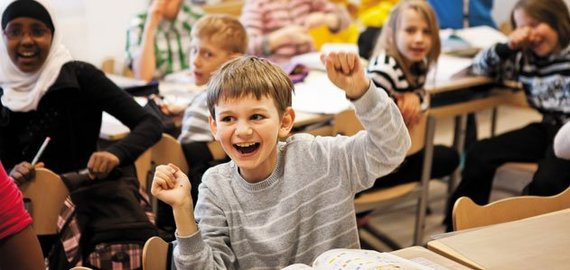Amanda Ripley, author of the best-seller The Smartest Kids in the World: And How They Got That Way, says education in Finland was the best in the world. If you want your kid to be smart, she has said, send them to Finland.
Yes, we know about Finland and The Program for International Student Assessment or PISA tests (Finland scores in reading, math and science at the top of all countries participating), and as Ripley writes, it's "a place where all the teachers (are) admired and all the children beloved." Only the top 10% get to teach, and the kids know that if you want a decent paying job education is a must. Oh, and standard testing, like "No Child Left Behind" requires, isn't something the Finns consider important.
But you seldom hear about the role of the arts in education.
This is curious in many ways as art education is taken very seriously in Finland's schools, and in every grade there are provisions to teach music, art, dance, visual arts and crafts as part of the basic education in all the schools.
Earlier this month, Robert Sabol, Professor of Visual and Performing Arts at Purdue University and former president of the National Arts Education Association, led a group to Finland to discover what role the arts has and is having on it's education system and the population in general. In fact, he said, the Finns see the "arts as a critical component to creativity." It ranks high on the education agenda, almost as high as math and science or any other discipline.
Furthermore, he said, wherever they went, at K-12 schools, universities, the Ministry of Education, art and art integration were seen as absolutely necessary to understanding the human condition, appreciating democratic values and insuring economic success. Music, the visual and performing arts are compulsory for all students up to age 16, in part, as an effort to promote creativity and problem-solving skills and boost learning in other subject areas.
The Minister of Education and Science, Henna Virkkunen, has become an advocate for increases in "art and skill subjects in basic education" to reflect the growing need for students to be "innovative." The Minister of Culture and Sport, Stefan Wallin, wholeheartedly agrees and has said, "Alongside education and research, art and culture constitute major building blocks of civilization. Moreover, as part of the creative economy, art and culture make a significant contribution to the competitiveness and growth of the national economy."
As Mikko Ketovuori, both a scientist and musician and lecturer at the University of Turku in Finland, has observed, "there is lack of research on the role of arts in Finnish curriculum." Even Pasi Sahlberg, he said, "the most famous scholar of Finnish education (coming from mathematics) does not really give any emphasis on arts in his book "Finnish Lessons". His advice though, "would be to add arts on general teacher education (K-12) as a mandatory part of graduation."
Maybe it's just that Finland assumes the arts are important and until recently hasn't emphasized its importance. There is no either/or, no STEAM versus STEM. As Ian Chia, founder of Being Prudence, has noted: "Finland has a long term approach to arts in education. Rather than valuing STEM (science, technology, engineering and mathematics) over the arts like many Western countries, Finland considers the arts to be vital and weaves it through their entire education system."

